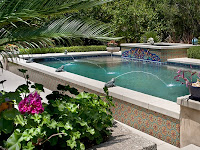How to Have A Perfectly Balanced Swimming Pool
Is
it possible to have a perfectly balanced pool? How do you balance a pool? What
is a balanced pool? Is it like Anakin bringing balance to the Force? And last
at what point is a pool considered balanced? These are all things I get asked
often (minus the Star Wars Nerd Question) and the answer is just as elusive as
these questions.
Let’s
start with the first question which is can you have a perfectly balanced pool?
Here are some ideal pool parameters and although they all differ slightly,
these are the preferred ranges across the industry.
Free
Chlorine 1.0-3.0 ppm
Combined
Chlorine 0 ppm
Bromine
4.0-6.0 ppm
pH
7.4-7.8
Total
Alkalinity 80-120 ppm
Calcium
Hardness 200-400 ppm
Cyanuric
Acid 30-50 ppm
TDS
<2000 ppm
ORP
650 or above
Is
there a way to adjust these readings in your pool to get them within these
ideal ranges? The answer is yes, with enough trial and error you can get your
test factors to line up with these guidelines.
The next question was how do you balance a pool? Basically, if the pH is high you
would add an acid like Muriatic Acid to lower down. If the pH was low you would
add a base to bring it up. If the Cyanuric Acid level is at 100 ppm you would
drain 50% of the water to drop it back down to 50 ppm. So by adding chemicals
or by partially draining your pool, you can get your reading within these
ranges. That is more or less the easy part.
What
exactly is a balanced pool is the question I think that should be asked. Is
having all of your readings in line with the above chart a balanced pool?
Technically no. Because what we are balancing is not these recommended
parameters but the water quality itself. Keeping the free chlorine in the range is
obviously important because if it gets too low the water may not be safe to
swim in since it is the chlorine acting as the sanitizer in the water that
kills viruses, bacteria, and pathogens. But to truly have a balanced pool you
really need to be looking at the LSI (The Langelier Saturation Index).
The
LSI is an index that was developed to indicate if a particular body of water
was either scale forming or acidic in nature. If for example, your pH is 6.5 it
is in the acidic range and the pool water would be corrosive. If the pH was 8.4
and the Alkalinity was 150 and the Calcium Hardness was 350 the water would be
scale forming. Both of these are not good and one reason that it is important
to shoot for the ideal ranges is to prevent the pool water from going in one or
the other direction, either corrosive or scale forming.
To
achieve a balanced pool you really need to calculate the pool’s LSI. This takes
into account many factors including water temperature, pH level, ALK level, CYA
level, Calcium Hardness, and the pools TDS (Total Dissolved Solids) to come up
with the range. The closer you get to 0.00 to +.30 the more perfectly balanced
your pool water will be. The interesting thing is that you may think your pool
is balanced but unless you plug your numbers into a good LSI calculator it may
actually be scale forming or corrosive. One of the best LSI calculators can be
found on the Orenda website here:
So
the short answer is you can come close to having a perfectly balanced pool but
if you are not using the LSI index in some fashion, you really are just
guessing even if you keep your pool within the ideal ranges.
YouTube Video Index: http://poolmandave.blogspot.com/2014/03/swimming-pool-tips-reviews-how-to-video.html – A
list of all of my videos.

Comments
Post a Comment